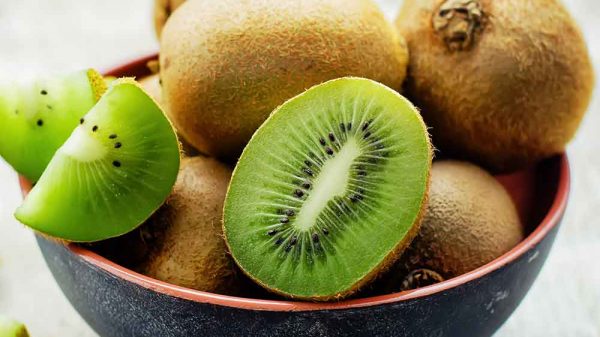The papaya – whose scientific name is Carica papaya– is a tasty fruit that grows in tropical climates. Papaya has long been regarded as a healing fruit; the papaya fruit and papaya enzyme have benefits that span nearly all organ systems, even the liver. Keep reading to find out why you should incorporate papaya fruit into your diet.
What Is Papaya Fruit?
Papaya is a rather large fruit, with a tough green skin and interior flesh that ranges from pink to orange in color. It is slightly sweet with a mild flavor, and the center of the fruit contains many rounds, black seeds. You can almost always find papaya at your local grocery store. Papaya fruit is popular in the United States and worldwide. The Food and Agriculture Organization of the United Nations estimated that nearly 7 million tons are produced each year. (1) A significant proportion of papaya production takes place in South America. Papaya is commonly consumed fresh but is also made into juices and jams.
The Papaya Enzyme Benefits Protein Digestion
What is the papain enzyme? Papain is the name of the enzyme that is naturally present in papaya fruit. Enzymes are organic protein molecules that catalyze biological reactions, and the shape of the enzyme determines what role it plays in the body. Every cell throughout our body relies on enzymes to carry out necessary functions.
For example, the digestive system relies on enzymes to break down the foods we eat. While carbohydrates and sugars tend to be easily and quickly processed, protein is much more difficult to break down and takes longer to pass through the digestive system. Protein breakdown is also particularly important since it produces individual amino acids that we require to build muscle, neurotransmitters, enzymes, and other protein-containing tissues.
The digestive tract already contains lots of mechanisms and digestive enzymes that break down the foods we eat. For example, amylase enzyme in saliva breaks down carbohydrates, while chymotrypsin and trypsin in the small intestine break down proteins.
However, since protein is so difficult to process, the body appreciates any help it can get! Papain is regarded as a proteolytic enzyme because it works by targeting bonds within dietary protein molecules. As a result, papain benefits protein breakdown and absorption of amino acids in the digestive tract. As an added benefit, research shows that papain may also exhibit anti-microbial activities, which could help you fight infection. (1)

Additional Benefits of Papaya Fruit
Check out these other beneficial characteristics of papaya and how they improve health.
1. Rich in Fiber
Fiber is another plus for digestive health. There are two types of dietary fiber: insoluble fiber and soluble fiber. While the body is able to break down soluble fiber, it is unable to break down insoluble fiber. Both insoluble and soluble fiber are critical for digestive health. Interestingly, because insoluble fiber is indigestible, it contributes virtually no calories! Dietary fiber helps prevent immediate absorption of the sugar that is present in fruits like papaya. As a result, energy from fruit sugar is sustained, instead of leading to a sugar spike followed by an energy crash.
Additionally, fiber helps facilitate the movement of food products through the digestive system. This helps prevent the lingering of excess protein in the lower digestive tract, which can lead to the overgrowth of harmful gut bacteria. On the other hand, complex carbohydrates and fiber in the digestive tract encourage the growth of healthy gut bacteria.
Studies also show that consuming high-fiber foods like papaya can help you lose weight while promoting digestive health.
2. Antioxidants
Papaya fruit is chock full of micronutrients like vitamins, polyphenols, and other particles that promote antioxidant activity. In particular, papaya contains high levels of vitamin C, flavonoids, and quercetin. Antioxidants are critical for reducing cellular damage associated with oxidative stress and inflammation associated with obesity, high blood pressure, insulin resistance, and cardiovascular disease. (1)
As it turns out, papain isn’t the only enzyme present in papaya. An enzyme called superoxide dismutase and other beneficial enzymes promote antioxidant activity and help inhibit inflammatory pathways in the liver and help reverse the damage associated with liver disease. (1)
As an added plus, papaya is low calorie and provides only a small proportion of your daily value of calories.
3. Anti-Microbial Activities
Papaya may fight against microbes that cause infection, including viruses, bacteria, and fungi. Papaya seeds may fight intestinal parasites, while the fruit has been shown to reduce malaria infection. Papaya may also play a role in fighting common bacteria implicated in human infections, like Escherichia coli and Staphylococcus aureus. (1)
How to Get the Full Benefits of Papaya
To reap the benefits of the papain enzyme and papaya, try eating freshly cut papaya before a protein-rich meal. Interestingly, bromelain from pineapple and actinidin from kiwi may exhibit similar effects. You may find that natural digestive enzymes feel like a digestive aid for an ailing tummy, helping to quell an upset stomach, indigestion, bloating, irritable bowel syndrome (IBS), heartburn, and other digestive problems. Protease enzymes like papain may be a natural alternative to antacids and other products.
Dietary supplements containing isolated papaya enzymes can also be found at your local drugstore in the form of chewable tablets. If you’re considering adding a papaya enzyme supplement to your regimen, always talk to your doctor or health care provider to make sure you get high-quality supplements that serve your particular medication condition. If you have any sensitivities, make sure you find supplements that are gluten-free and vegan.
To get the most out of papaya fruit, it’s best to consume the whole fruit to retain fiber, enzyme, and nutrient content. Though papaya juice and jams are tasty, they may contain preservatives, artificial papaya flavor, artificial color, and added sugar.
Other products containing papaya components include papaya seed oil, which isolates oleic acid, palmitic acid, linoleic acid, and stearic acid from papaya seeds to create a healthy fat source.
How to Eat Papaya Fresh
Eating papaya can seem tricky, but it’s actually quite simple. First, slice the papaya in half lengthwise. Further divide the slices so that the papaya is now in quarters. Scrape out the black seeds and eat the papaya straight out of the skin using a spoon!
If you’d rather eat pieces of papaya, first cut the papaya into quarters as described above. Carefully using a knife, cut the fruit away from the tough skin. Then, cut the fruit into bite-size pieces.
Conclusion
Next time you go to the grocery store, try adding papaya to your cart and enjoy a tasty fruit that benefits digestive health.
References:























